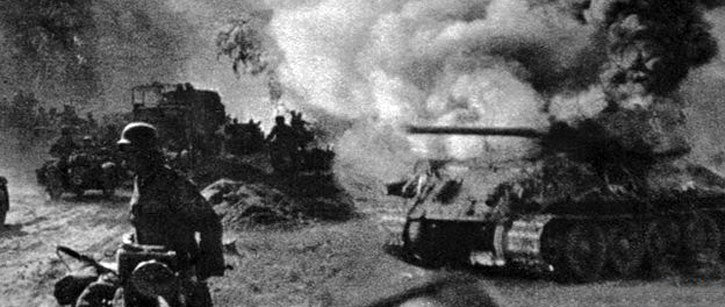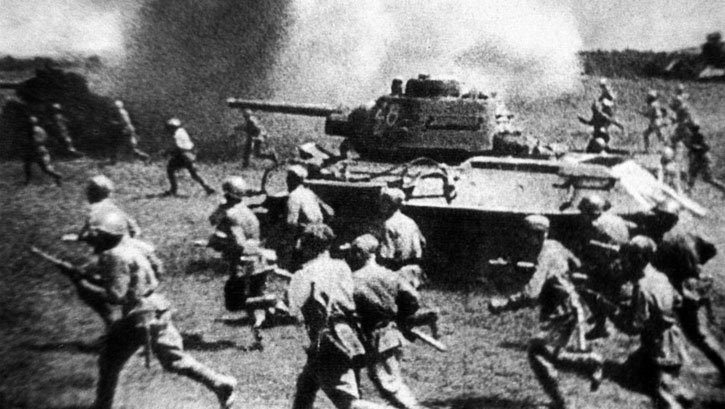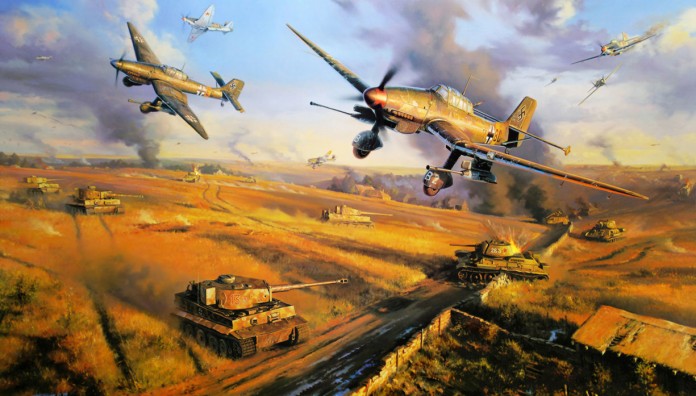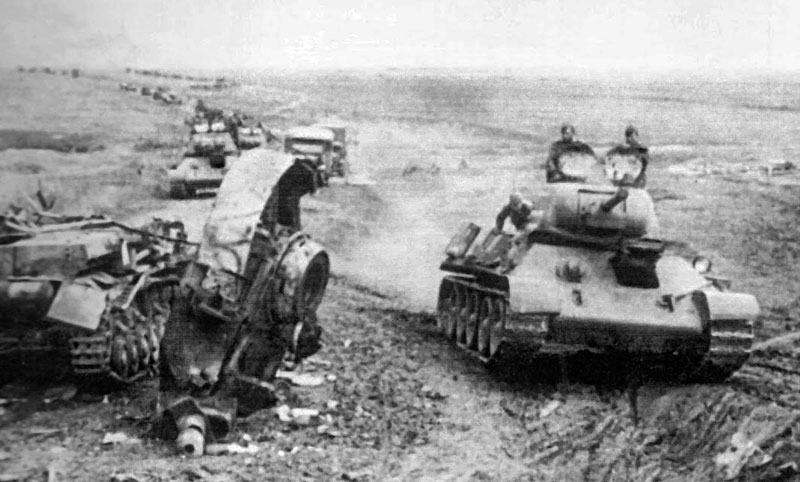

Broadly speaking, the German plan for Citadel was relatively simple indeed: The Kursk “Bulge” created the ideal conditions to “pinch” the entire Russian frontline, with two massive armored thrusts, 9th Army from the north and Fourth Panzer Army from the south, smashing the Soviet defenses to link up east of Kursk, thus encircling the entire Russian forces in the Bulge. Success depended on massive fire power, speed and courage of the panzer crews advancing relentless with heavy air cover, smashing all in their way.

[nonmember]

[/nonmember][ismember]The main thrust was to be made by 4th Panzer Army commanded by General Hermann “Papa” Hoth, one of the top Panzer experts. Hoth, born 1885 son of an army doctor, fought in WW1 with a distinguished record. Hoth’s 4th Panzer Army had been massively reinforced, and contained more tanks than any other German Army of the war – a total of 700, including a strong detachment of PzVI Tigers.
His army was to be the armored spearhead for Manstein’s Army Group South, forming the southern pincer, attacking on both sides of Tomarovka, by 48th Panzer and 2nd SS Panzer Corps. The latter was a very strong force, under its command were three elite SS armored formations, 1st SS Leibstandarte Division, the so-called Hitler’s Body Guard, equipped with 12 Tiger Is, 72 Panzer IVG a number of older types, but with a unit of the latest assault guns, the turretless Sturmgeschütz III, one of the most successful self-propelled guns of the war, mounting the 75mm/L70. which were very effective weapons, due to their low silhouette. Also included were 2nd SS Panzer and 3rd SS Panzer Divisions, the latter infamous due to its insignia, the death Head. The latter were PzGrenadier units but with armored assault gun battalions.
Operating on its right flank, was Army Detachment Kempf, commanded by General Werner Kempf a seasoned panzer officer. His force was to advance and guard the northeastern flank for the main drive. In this formation, were two panzer divisions and the elite panzer grenadier division “Gross Deutschland” (greater Germany), one of the strongest formations in the 1943 Wehrmacht. Although nominated ‘mounted infantry’, it was virtually the strongest outfitted armored unit that fought at Kursk. It mustered no less than 180 tanks, including eighty brand new PzV Panthers, commanded by an experienced tanker, Colonel Meirad von Lauchert with a strong artillery regiment under its command. In all, Colonel General Hoth’s Army could mount some 925 tanks and 170 assault guns, of which 200 were PzV Panther and 48 Tiger I.
Preliminary fighting started in the southern part of the salient on the evening of 4 July 1943, when German infantry forces launched probing attacks to seize the high ground suitable for artillery observation posts prior to the main assault scheduled for 5 July. This was to be opened by a massive artillery barrage and powerful air strikes on the soviet defenses. The aim of these preliminary moves was to gain lodgments in the forward line of Russian defenses, preparing the full weight of the Fourth Panzer Army, planned for the coming morning.
Vanguard of the 11Pz Division tanks and Grenadiers struck the Soviet outposts with full surprise, but a fierce fight ensued, as the German grenadiers entered into a prepared defense zone and first casualties were reported. After midnight, the German advance stopped and soldiers dug in, awaiting the planned artillery barrage, which was scheduled to start next dawn. Meanwhile along the two fronts, a massive troop movement commenced, as the prepared assembly areas became congested with men and tanks. Suddenly a heavy thunderstorm started, violent lightning followed by torrential rain which engulfed the German troops, turning the ground within minutes into a deep morass. Confusion raged as tanks, assault guns, horse-drawn artillery and infantry-carrying armored cars, mingled in the darkness, sinking into the unending quagmire. Officers were frantically trying to restore some order, when adding to the maze, suddenly accurate Russian artillery pounded the hapless troops, causing heavy casualties among the unprotected soldiers.

As dawn broke into the first day of the Battle of Kursk, the fighting started in earnest, as the Panzers broke into the first Russian defenses, supported by a massive artillery barrage and screaming Stuka Dive bombers, falling like birds of prey onto the Soviet positions. The German Panzer generals were acutely aware of the vulnerability of their new heavy armored vehicles, especially the mammoth Ferdinand self propelled guns- which were extremely prone to approaching infantry tank killer teams. To protect the advancing tanks, accompanying infantry were to protect the armor, inevitably suffering heavy casualties. The first tank vs tank encounters were fought as the German panzers entered into the Soviet positions and came upon the Russian armored reserves hidden behind the forward line. A Russian officer, who lived through the carnage, remembered his shock in the first counter attack: ” After several minutes of firing on the move, the attacking echelon of our T-34s cut into the Nazi ranks with a thrust forward—a rapid assault literally smashing through the enemy infantry protecting the tanks. Now the Tigers and Panther monsters, deprived in the melee of their advantage in firepower and protection, as we closed in, started to get hit. Smoke and dust swirled all over the battlefield. The earth shook from the powerful blasts. The battlefield turned into sheer Hell, as tanks struck each other and, having grappled, could not cut themselves loose and fought to the death, until the area was strewn with exploding vehicles, dazed survivors running frantically searching cover which could not be found, only to be cut down by machine gun fire. Tanks that had been knocked out, or lost their tracks, but whose weapons were still functioning, continued to fire, until they too became blazing hulks, deathtraps for their hapless crews.”
A German tank crewman saw the battle through his Periscope: “Suddenly a T-34 broke through and headed straight for us. Our radio operator/loader started giving me shells to push into the gun. At this time, our tank commander above us was screaming ‘Fire! Fire!’ nonstop, because the tank was getting closer; but only after the fourth ‘Fire!’ I heard his ‘Thank God!’ Luckily we survived, but soon found out that the Russian was stopped just eight meters from us burning fiercely, his ammunition exploding. Looking round amazed, I noticed high on our turret a large hole that a Russian armor piercing round had created, but no one was hurt, we had survived our first encounter at Kursk, but there was more to come!”

Reeled by the shock of their first encounter the German panzer attack seemed to stagger, but the aid came swiftly from the sky as Captain Hans Rudel’s squadron of nine tank-busting Ju-87 G-1, newly armed with twin deadly BK37mm cannons fitted under the wings, swooped in low. Firing hard core APCR Tungsten) ammunition or high explosive shells at 160 rounds per minute, they created devastating results with the enemy tanks. The BK-37 was employed in a top attack profile against the especially thin upper turret and engine compartment armor of a T-34. Rudels Stukas screamed into the frey, blasting the enemy tanks diving on them down to a few meters height. “We were all seized with a kind of passion for the chase from the glorious feeling of having saved much German bloodshed with every tank destroyed,” the Luftwaffe Stuka Ace Rudel told later. The Stukas came not a moment to soon, as more Russian tanks approached the battlefield, coming out of their hideouts in the woods nearby. Rudel had developed new tactics for his “Panzerknocker” Stukas. He found that the best way to knock out tanks was to hit them in the back, where the rear-mounted power pack is located, its cooling system protected with lesser armor plates. But by going in that low, nearly on the “deck” some of his pilots were hit by Russian small arms fire from the tanks and crash-landed right near the advancing panzers. Some pilots, surviving the crash even continued fighting as tankers replacing wounded crew members, such was the combat morale, at least during the first phase of the battle. It changed for the worse as the carnage grew.[/ismember]
As the Germans managed finally to break through the Russian forward lines, while suffering heavy casualties, they ran into improvised minefield which soldiers recruited from the notorious Soviet penalty battalions quickly laid out, disregarding the withering fire from the advancing panzers. Only one or two out of dozens of these unfortunate troops survived, the rest blew up by their own mines or were squashed by the panzers as they drove over them and blowing up the mines, all involved suffering a horrible death.
The attack halted under heavy fire right in front of the Russian defenses. As one German survivor told:” the panzers were supposed to attack, but looking back I saw them stuck in a minefield, some exploding, with their crews bailing out only to be killed by enemy fire. With the tanks stuck fast, it was up to us to enter the enemy trenches and a savage hand-to-hand melee started with no quarter taken or given. All round me, men fell, Russians and Germans grappeled for life and death. Tremendous confusion raged, within minutes we suffered dozens of casualties, but no rescue was possible, as the medics fell too in the carnage. Ten more nerve shaking hours were to pass until the panzers finally managed to extricate themselves from the minefield and came to our rescue. By them most of our company lay dead or severely wounded in the trenches”.












